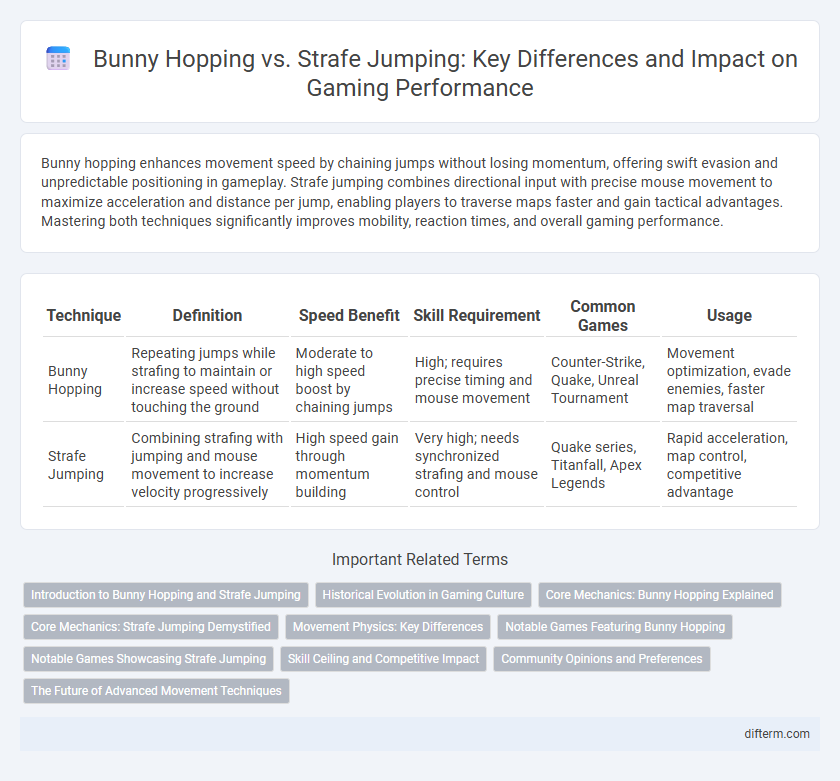Bunny hopping enhances movement speed by chaining jumps without losing momentum, offering swift evasion and unpredictable positioning in gameplay. Strafe jumping combines directional input with precise mouse movement to maximize acceleration and distance per jump, enabling players to traverse maps faster and gain tactical advantages. Mastering both techniques significantly improves mobility, reaction times, and overall gaming performance.
Table of Comparison
| Technique | Definition | Speed Benefit | Skill Requirement | Common Games | Usage |
|---|---|---|---|---|---|
| Bunny Hopping | Repeating jumps while strafing to maintain or increase speed without touching the ground | Moderate to high speed boost by chaining jumps | High; requires precise timing and mouse movement | Counter-Strike, Quake, Unreal Tournament | Movement optimization, evade enemies, faster map traversal |
| Strafe Jumping | Combining strafing with jumping and mouse movement to increase velocity progressively | High speed gain through momentum building | Very high; needs synchronized strafing and mouse control | Quake series, Titanfall, Apex Legends | Rapid acceleration, map control, competitive advantage |
Introduction to Bunny Hopping and Strafe Jumping
Bunny hopping and strafe jumping are advanced movement techniques used in first-person shooters to gain speed and maneuverability. Bunny hopping involves rhythmically timing jumps to maintain momentum and evade enemy fire, while strafe jumping combines precise air control and mouse movements to accelerate beyond normal running speed. Mastering these skills enhances gameplay by improving map traversal and combat positioning.
Historical Evolution in Gaming Culture
Bunny hopping and strafe jumping originated in early first-person shooters like Quake and Counter-Strike, becoming essential movement techniques for gaining speed and evading opponents. These mechanics evolved through player experimentation and influenced game design by introducing skill-based movement that rewarded precision and timing. Over time, bunny hopping and strafe jumping have become iconic elements of competitive gaming culture, shaping player strategies and speedrunning communities.
Core Mechanics: Bunny Hopping Explained
Bunny hopping is a core movement mechanic in gaming that allows players to maintain or increase speed by timing jumps precisely while strafing in mid-air. This technique exploits the game's physics engine to minimize friction and momentum loss, enabling faster traversal across maps. Mastery of bunny hopping requires precise input timing and awareness of in-game movement mechanics to gain a competitive edge.
Core Mechanics: Strafe Jumping Demystified
Strafe jumping is a core movement mechanic in gaming that combines forward momentum with precise air strafing and mouse input to achieve faster speeds and longer jumps. Unlike bunny hopping, which relies on timing repeated jumps to maintain velocity, strafe jumping requires mastering angular control and synchronization between key presses and mouse movements. Understanding these mechanics allows players to optimize movement efficiency and gain a competitive edge in speed-based gameplay.
Movement Physics: Key Differences
Bunny hopping exploits momentum by chaining jumps to maintain speed, relying on precise timing and in-air control to minimize friction and vertical velocity loss. Strafe jumping combines angled strafing inputs with mouse movement to accelerate incrementally, enhancing horizontal speed through optimized movement physics. The key difference lies in bunny hopping's focus on momentum preservation versus strafe jumping's technique for speed gain via directional input synergy.
Notable Games Featuring Bunny Hopping
Bunny hopping, a popular movement technique, is prominently featured in games like Counter-Strike, Quake, and Apex Legends, where players exploit momentum to gain speed and evade enemies. This technique relies on repeated jumping combined with precise air control, allowing skilled players to navigate maps faster than standard movement permits. Notable for enhancing both mobility and tactical advantage, bunny hopping remains a key element in competitive first-person shooters.
Notable Games Showcasing Strafe Jumping
Notable games showcasing strafe jumping include Half-Life, Quake, and Counter-Strike, where this advanced movement technique offers players enhanced speed and maneuverability. Strafe jumping enables precise air control and quicker map traversal, distinguishing competitive gameplay from bunny hopping's simpler jump mechanics. Mastery of strafe jumping often correlates with higher skill levels and improved performance in these classic first-person shooters.
Skill Ceiling and Competitive Impact
Bunny hopping and strafe jumping both elevate a player's movement skill ceiling, with strafe jumping demanding precise mouse and keyboard coordination for smoother acceleration and direction control. Bunny hopping provides rapid momentum boosts through timed jumps, often easier to execute but less nuanced than strafe jumping's intricacies. In competitive gaming, mastering strafe jumping grants significant map control advantages, while bunny hopping offers quick escapes or repositioning, each shaping player strategies and meta gameplay differently.
Community Opinions and Preferences
Bunny hopping and strafe jumping both hold iconic status in gaming communities, with bunny hopping favored for its rhythmic timing and ease of learning. Strafe jumping appeals to advanced players seeking higher speed gains and precision movement, often seen in competitive settings. Community discussions reveal a divide, where casual gamers prefer bunny hopping's accessibility, while veterans advocate strafe jumping for its skill ceiling and strategic advantages.
The Future of Advanced Movement Techniques
Bunny hopping and strafe jumping continue to evolve as foundational advanced movement techniques in competitive gaming, enabling players to maximize speed and agility in FPS titles. Emerging technologies like machine learning and enhanced player input analysis are expected to refine these mechanics, offering new layers of precision and responsiveness. Future game designs may integrate these techniques inherently, transforming movement into a strategic skill rather than a glitch exploit.
Bunny Hopping vs Strafe Jumping Infographic

 difterm.com
difterm.com